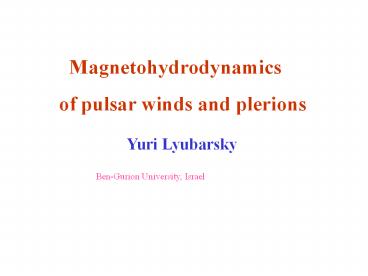Magnetohydrodynamics - PowerPoint PPT Presentation
Title:
Magnetohydrodynamics
Description:
Magnetohydrodynamics. of pulsar winds and plerions. Yuri Lyubarsky. Ben-Gurion University, Israel ... the electric and magnetic forces nearly cancel each other ... – PowerPoint PPT presentation
Number of Views:134
Avg rating:3.0/5.0
Title: Magnetohydrodynamics
1
Magnetohydrodynamics of pulsar winds and
plerions
Yuri Lyubarsky
Ben-Gurion University, Israel
2
Pulsar magnetosphere
Pulsar wind
Pulsar wind nebula
electro-magnetic fields
3
j
j
B
v
v
v
j
j
v
v
B
v
v
j
j
v
4
The hoop stress
j
F
B
Magnetic hoop stress
Total force
As
the electric and magnetic forces nearly cancel
each other
5
In the far zone, the magnetic field is nearly
azimuthal
6
Obliquely rotating magnetosphere
B
B
equatorial
plane
B
B
7
How the electromagnetic energy is transformed
into the plasma energy?
Non-oscillating fields no energy release
mechanism
Waves various dissipation mechanisms
(Usov 1975 Michel 1982, 1994 Coroniti 1990
Melatos Melrose 1996 Lyubarsky Kirk
2001 Lyubarsky 2003 Kirk
Skjaeraasen 2003 Melatos Skjeraasen
2004)
8
Observations suggest that the energy flows from
the pulsar predominantly within the equatorial
belt
What theory says about the angular distribution
of the energy flux in the pulsar wind?
9
Split monopole solution Michel (1973) aligned
rotator Bogovalov (1999) oblique rotator
10
B
B
equatorial
plane
magnetosphere
current sheet
B
B
In the equatorial belt, most of the energy is
transferred by alternating electro-magnetic field
11
The fate of the alternating field
1. Dissipation in the wind very difficult,
extreme assumption (LyubarskyKirk 2001
KirkSkjaeraasen 2003)
2.Dissipation at the termination shock
driven reconnection (Lyubarsky, in progress)
12
The shock in a striped wind (1.5D PIC simulations)
13
(No Transcript)
14
B2/8p
15
MHD flow beyond the termination shock is
determined only by the total energy flux and the
mean magnetic field in the wind
16
The mean field0 at the equator
and at the axis
17
Origin of the get-torus structure (Lyubarsky 2002)
magnetic collimation
disk
disk
termination shock
18
MHD simulations of the pulsar wind nebula
Komissarov Lyubarsky 2003
19
Pulsar plasma fills in the cavity within the
expanded cold envelope
magnetic field and velocity
expansion velocity 5000 km/s
20
Gas pressure and velocity field around the
termination shock
towards the observer
sprite
rim shock
bright arch
fluff
--DISK---
termination shock
Mach belt
c
21
Magnetic pressure/gas pressure
22
Simulated images
s0.004
s0.009
s0.025
23
Simulated image, s0.009, with magnetic field at
the axis
sprite
fluff
sprite
bright arch
jet
rim shocks
24
Chandra image of the Crab Nebula
fluff
Bright Arch
Counterjet
Polar Jet
25
Particle acceleration at the termination shock
in a striped wind
26
electron energy spectrum
N(E)
E-1.6
E-1.6
injection spectrum
E-2.2
1000
10
E, GeV
0.1
Radio emitting electrons are accelerated now in
the same region as the ones responsible for
optical to X-ray emission (Gallant Tuffs
Bietenholtz, Frail Hester)
27
Difference image at 4615 MHz (1998 Aug 9-Oct 13)
28
1 TeV
from
to
MeV
Particle acceleration in the standard (kinetic
energy dominated) shock
N(E)
shock
E
mc2
Fermi acceleration at ultra-relativistic shocks
(Bednarz Ostrowski 1998 Gallant Achterberg
1999 Kirk, Guthman, Gallant Achterberg 2000)
29
1. Gallant, van der Swalluw, Kirk, Achterberg
(2002) Ion dominated wind
2. Lyubarsky (2003) Dissipation of the Poynting
flux at the termination shock
30
Conclusions
1. Most of the energy is transferred in the
equatorial belt by alternating magnetic
fields
2. Magnetization of the postshock flow is
determined only by the mean magnetic field (0 at
the equator)
3. Termination shock is highly non-spherical
4. The jet is formed beyond the termination shock
31
Unsolved problems
1. Azimuthal symmetry of the internal ring.
2. Wisps
3. Flat spectrum of the radio emitting electrons
32
(No Transcript)
33
Crabs jet
HST
Chandra
difference image

